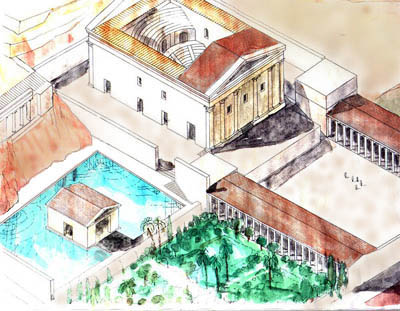Pipe Dreams and Paradise: The Water System of the Petra Garden and Pool Complex

Dr. Leigh-Ann Bedal
ACOR-CAORC Fellow and Associate Professor of Anthropology at the Behrend College of the Pennsylvania State University
Wednesday 29 October 2014 at 6:00pm
Reception to Follow
About the Lecture
Visitors to Petra are characteristically amazed by its immense scale, imposing monuments, and dramatic sheer cliffs of variegated hues. When visitors encounter some of the many water control and transport features visible throughout the ancient city—channels, aqueducts, cisterns, dams, and pipelines—they understand that a sophisticated hydraulic system was essential for the city and its population to thrive in the desert. What is usually not imagined by most visitors to Petra is that the highly developed water system was designed not only to serve the basic needs of the people and their animals and crops, but also to produce a surplus of water used for display and recreation, an exhibition of conspicuous consumption that signifies abundance, wealth, and power. The most grand example of the use of water for display and leisure is the pleasure garden (paradeisos), located at heart of the city center.
Unknown to surveyors and archaeologists working in Petra for nearly a century of exploration, the Petra Garden and Pool Complex was first identified in 1998 and, since then, has been undergoing archeological excavation, under the direction of Dr. Leigh-Ann Bedal. It is the only known example of a Nabataean garden and the only example of garden archaeology to be conducted in Jordan. The excavations have revealed remains of a recreational pool with an island-pavilion overlooking an expansive cultivated terrace with pathways for strolling and viewing. Discoveries of flower pots and planting pits and archaeo-botanical materials provide evidence about cultivation. Of course, a complex water system was necessary to irrigate the garden and fill the monumental pool. This lecture will address the elements of the water system that have been uncovered through excavation and what they have to tell us about the historical development, design, and function of the Petra Garden and Pool Complex.
About the Lecturer
Leigh-Ann Bedal is currently an ACOR-CAORC Fellow in Amman and she is an Assistant Professor in Anthropology at the Behrend College of the Pennsylvania State University. She specializes in Near Eastern archaeology, urbanization, and garden archaeology. She is the Project Director of the Petra Garden and Pool-Complex Excavation and has published a number of articles and survey reports from the site. She received her degrees from California State University (B.A.), University of California, Berkeley (M.A.) and the University of Pennsylvania (Ph.D.).